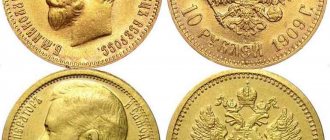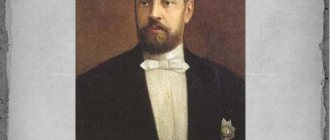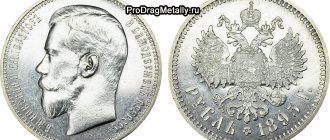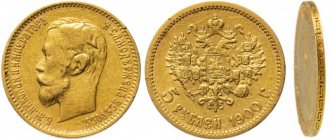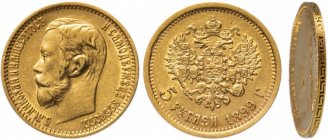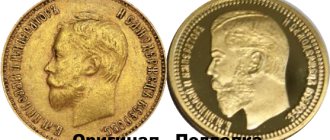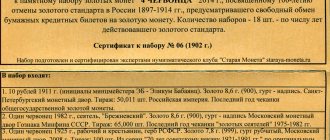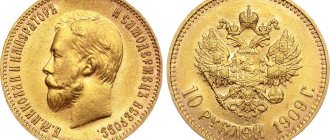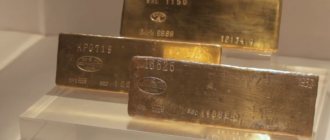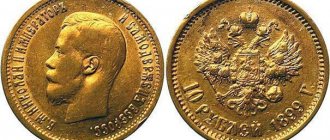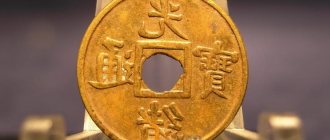Story
At the end of the 19th century, gold mining was actively carried out in Russia. By 1893, the quantity of the precious metal accounted for 17% of world production (41,842 kg). Due to this, the country took fourth place (quite prestigious within the framework of global gold mining). In a short period of time, from 1881 to 1897, the gold reserves increased by 3.5 times. The influx of precious metal contributed to the fact that the credit ruble was strictly tied to the precious metal, and monometallism was established in the state.
In 1895, monetary reform was announced in Russia. Its initiator was the financial genius S. Yu. Witte. Reform was a necessity to strengthen the national currency. This required increasing the production of coins made of precious metals and reducing the amount of paper money. Tsar Nicholas II approved a new edition of the coin regulations. According to it, the ruble acted as the monetary unit of Russia, which facilitated exchange transactions in the country and abroad (trade was carried out with the USA and Great Britain, and these countries were more willing to accept the “gold standard” instead of bills).
Did you know? 5 rubles of Nicholas II personified the prosperity and power of the Russian Empire, were valued as the best and most reliable currency and were in free circulation until 1917. They witnessed dramatic events associated with the history of World War II - such coins were part of the gold reserves of European countries (England, Germany, Hungary) that ended up fighting each other on opposite sides of the trenches.
S. Yu. Witte assessed Russia's monetary reform extremely positively. He noted that the work done was the reason that “Russia’s monetary circulation has been put in order and is as firmly established as in those states where this branch of the national economy has long been in exemplary condition.” After just three years, the gold backing of the ruble became 168%.
Did you know? Despite popular myths, Nicholas II was not the richest man in Russia. In 1913 (the last pre-war year), the amount in the Tsar’s personal account was about one million rubles. Industrialist Nikolai Vtorov, according to Forbes of that time, in the same year had an amount of more than 60 million rubles.
The reform of the coin standard introduced many features:
- paper money has practically depreciated and gone out of circulation;
- Nicholas II resumed portrait coinage, abolished by Tsar Paul I;
- the weight of money made from precious metals has decreased.
According to the reform, the name of the new currency was to be replaced with “Rus”. For this purpose, test pieces were minted from gold (5, 10, 15 “Rus” with a weight of 4.3, 8.6, 12, 9 g). The idea never took root - Nicholas II did not accept this replacement. A total of 5 sets of three coins were issued. One set is currently valued at $400,000.
Beginning in 1897, the Mint began minting samples in denominations of 5 and 10 rubles, but only the coin with a denomination of 5 rubles became popular and turned out to be the most in demand. A huge number were produced in three years (the largest circulation took place in 1898 - 52 million copies). For the first three years, the weight of the coins was quite large (12.9 g), but there was a need to reduce the weight in order to replenish the state treasury. The weight of the five-ruble gold coin was 4.3 g.
Did you know? Russian gold 5-ruble coins, minted under Tsar Nicholas II, are the only gold coins of Central and Eastern Europe of the late 19th and early 20th centuries, still famous and valued throughout the world, thanks to their excellent quality and the highest degree of protection against counterfeiting, which in which they are not inferior to modern gold and silver coins of Russia.
The popularity of 5 rubles (1897-1911) became the reason for frequent counterfeits. Some specimens look so natural that it is impossible to distinguish them from the original without the participation of an expert. The reason for frequent counterfeiting is confusion with circulation. During the revolution, chaos reigned at the Mint, and the fate of some stamps is unknown. According to one version, Admiral Kolchak took possession of the stamp in order to mint coins for the army.
In addition, after the creation of the RSFSR, the Mint continued minting 5 rubles of Nicholas II. This is due to the fact that the new state did not have the funds to create its own stamp and equipment, but needed money to make payments. Despite the fact that gold coins were minted several years later, they are considered no less valuable among numismatists.
Golden 5-ruble note: from Elizabeth to Nicholas II
Until the 18th century, there was no systematic and mass minting of gold coins in our country. The history of Russian numismatics knows about Prince Vladimir’s gold coins, gold hryvnias from the period of feudal fragmentation, trial and donative issues of gold coins in the Muscovite Kingdom in the late 15th – 17th centuries. However, these numismatic artifacts have never been produced regularly and en masse. These are unique numismatic monuments.
Why did the Russian monetary system for many centuries actually not know a gold coin? The answer is simple. Until the 18th century, our country did not have its own gold mining. A few gold coins were minted from the limited amount of foreign gold that came to Rus' during trade and exchange.
Purposeful large-scale searches for gold began only under Peter I, when impurities of gold were accidentally discovered in the copper and silver Nerchinsk ores of Transbaikalia.
Emperor Peter I. Portrait by Andrei Matveev. 1724-1725
However, the reformer king and his immediate successors were not yet destined to see a gold coin made from metal of their own production. The discovery at the Nerchinsk mines was conveniently forgotten for several decades, since Russia did not yet have the technology to separate gold from the ores of other metals. In the 1740-50s, gold was discovered in the Urals. Soon several mines for the extraction of gold ore were opened there. At the same time, refining (separation of pure gold from ore masses) was established at the St. Petersburg Mint. The Ural mines have become the object of close government attention. In the middle of the 18th century, more than 9 thousand peasants were assigned to them for work.
Empress Elizaveta Petrovna. Painting by an unknown artist from the mid-18th century
The production of gold coins from metal of its own production began only during the reign of Empress Elizabeth Petrovna (1741-1761). At the same time, the first 5-ruble gold coins were minted. In 1755-1759, more than 60 thousand gold five-ruble notes were issued.
5 rubles 1756
Under Elizaveta Petrovna, the design and weight standard of a coin with a face value of 5 rubles was approved. The coins were issued at the St. Petersburg Mint. The obverse depicted the profile of the empress with a rather thick build with a ribbon of the Order of the Apostle Andrew the First-Called over her shoulder. Around the circumference, clockwise, was minted the inscription “B•M•ELISAVETH•I•IMP•ISAMOD•ALL-RUSSIAN”, which stands for “By the grace of God, Elizabeth I, Empress and Autocrat of All Russia.” On the reverse of the coin in the center there is a small state emblem, around which, in a cross shape, in figured cartouches, the coats of arms of the kingdoms that are part of the Russian Empire are depicted: Moscow (above), Kazan (right), Siberian (below) and Astrakhan (left). Above all the cartouches there are jagged royal crowns, only above the cartouche with the Moscow coat of arms is an imperial crown. On the edge, in a circle, there is an inscription of four parts “IMPERIAL RUSSIA MON•PRICE FIVE•RUB”, which stands for “imperial Russian coin, price - 5 rubles”. The diameter of the coin circle is 25 mm. The weight of pure metal is 7.57 (with a total weight of the coin of 8.26 g). The coins were minted from 917 gold. The edge of the coin is cord-shaped and slopes to the right.
The design and technical characteristics of gold 5-ruble coins remained unchanged for almost half a century, until the reign of Paul I. Only the portraits of the ruling monarchs, the designations of the mints and the initials of the mintmaster changed.
5 rubles of Peter III. 1762
About 9.5 thousand 5-ruble coins were minted during the short reign of Emperor Peter III in 1762. The 5 rubles of Peter differ from the Elizabethan coins only by the presence of a portrait of the new emperor. During the long reign of Catherine II (1762-1796), three varieties of gold five-ruble coins were issued, differing only in the portrait of the empress. Also, under Catherine, the name was assigned to the five-ruble coin - semi-imperial.
5 rubles of Catherine II. 1 type 1762
Type 1 - “with a scarf around the neck” was minted in 1762-1765, type 2 - “without a scarf” was issued in 1766-1776 and type 3 - “late portrait” was minted in 1777-1796. It has the varieties “longer neck” (1777-82) and “shorter neck” (1783-96). The technical characteristics of the coin have not changed since the time of Elizabeth Petrovna.
5 rubles of Catherine II. Type 2 1770
5 rubles of Catherine II. Type 3 1788 From the collection of the Goznak Museum
Under Emperor Paul I (1796-1801), both the design of five-ruble coins and their technical characteristics changed dramatically. Pavel Petrovich broke everything that connected his reign with the era of his unloved mother. Apparently, this is associated with a sharp change in the design of not only gold coins, but also silver and copper.
The gold five-ruble note, issued in 1798-1801, had only one type. The weight of the coin decreased to 6.09 g (with the weight of pure metal being 5.99 g). The diameter of the coin circle is 23 mm. But at the same time, the standard of the metal increased, it increased from 917 to 986. The coin has a cord-like edge.
5 rubles of Paul I. 1799
The obverse side of the five-ruble coin depicts the monogram of Emperor Paul in the form of four large letters “P”, crowned with crowns, connected at the base and located around the Roman numeral “I”. The numbers “5” are minted between the letters. Paul's monogram was created by analogy with the monogram of Peter the Great, only there the letters "P" are connected not by the bases, but by the upper part. Also on the obverse, around the imperial monogram, there is an inscription in a circle - “FIVE RUBLES OF 1798”.
Monogram of Peter I on the ruble of 1725
For the first time in the history of Russian numismatics, a quotation from the Bible appeared on the silver and gold coins of Paul I. It is also minted on the reverse of a gold five-ruble coin. This is an abbreviated verse from Psalm 113: “NOT TO US, BUT TO THY NAME” (full quotation: “Not to us, O Lord, not to us, but to Thy name give glory, for the sake of Thy mercy, for the sake of Thy truth”). Below, under the quotation, the mint and the initials of the mintmaster are indicated.
Under Alexander I, mints returned to the old, Catherine design of gold coins while maintaining the main Pavlovian technical characteristics. This corresponds to the general mood of the new emperor, who declared a return to the principles of the rule of his “blessed grandmother” Catherine. Involved in the murder of his father, Emperor Paul, committed by conspirators on March 11, 1801, Alexander Pavlovich, throughout his reign, tried to erase his father’s name from the pages of history. As we can see, this even affected the design of coins.
Five-ruble coins were minted twice under Alexander I - in 1802-1805 and in 1817-1825. These were two different types of coins.
5 rubles of Alexander I. Type 1. 1804
Type 1 – on the obverse there is a cross made of cartouches with the coats of arms of the kingdoms around the state coat of arms surrounded by the inscription “FIVE RUBLES 1804”; and on the reverse there is the inscription “STATE RUSSIAN COIN” framed by laurel and oak branches under the crown, below is the abbreviation of the mint.
5 rubles of Alexander I. Type 2. 1818
Since 1817, the design of five-ruble gold coins has changed: a new type of coat of arms appears on the obverse (an eagle with lowered wings), and the content of pure precious metal is indicated on the reverse - 1 spool of 39 shares. The fineness of the metal was reduced from 986 to 917. The weight of the coin was increased to 6.54 g (with the weight of pure metal being 6 g). The coin has become smaller in diameter (22.6 mm), but slightly thicker.
During the reign of Nicholas I (1825-1855), the five-ruble coin was the only denomination minted in gold. There are two known varieties of the Nikolaev five-ruble coin.
5 rubles of Nicholas I. Type 1. 1827
In 1826-1831, coins were issued based on the model of the second type of five-ruble coin of Alexander I. From 1832 until the end of the reign of Nikolai Pavlovich in 1855, coins of the second type were minted - with an “eagle with raised wings” on the obverse and an indication of the denomination and pure metal content on the reverse .
5 rubles of Nicholas I. Type 2. 1854
In the first four years of the reign of Emperor Alexander II (1855-1858), gold 5 rubles were issued according to the second type of Nicholas rubles with an “eagle with raised wings.”
5 rubles of Alexander II. Type 1. 1856
Subsequently, there is a change in the design of the state emblem (“an eagle with short wings”). 5 rubles of the second type were issued until the end of the reign of Alexander II and even several years after.
5 rubles of Alexander II. Type 2 1863
All coins had the designations of the St. Petersburg Mint and the initials of the mintmaster. The technical characteristics of the five-ruble gold coin under Alexander II have not changed since the time of minting the second type of 5 rubles of Alexander I (1817).
5 rubles of Alexander III. 1 type 1884
During the reign of Alexander III (1881-1894), two types of 5-ruble coins were minted. From 1881 to 1886, 5 rubles were issued with a coat of arms design based on the 1859 model.
5 rubles of Alexander III. Type 2 1889
In 1886-1894, coins of the second type were minted with a reduced standard (900 instead of 917). The weight of the coin was also reduced. The design is borrowed from 10 rubles: a portrait and title of the emperor on the obverse, a coat of arms, denomination and date on the reverse. The initials of the mintzmeister began to be minted on the edge of the coin. The content of pure metal was also indicated on the edge (1 spool = 34.68 shares).
At the end of the 19th century, under Emperor Nicholas II, a transition to gold monometallism was carried out in Russia (monetary reform by S.Yu. Witte). Instead of silver, the gold ruble became the basis of the empire's monetary system. By maintaining the same 900 fineness, the weight of the gold coin is reduced to 4.3 g (3.87 g of pure metal). The diameter of the coin circle is 18.5 mm, thickness is 1.2 mm.
5 rubles of Nicholas II. 1898
On the obverse of the coin is the profile of the king to the left and the title around the circumference. On the reverse is the state emblem, under which the denomination and year of issue are minted. Five-ruble coins of Nicholas II were minted from 1897 to 1911 (with the exception of 1905 and 1908). The coins issued in 1907 are numismatic rarities, as just over 100 of them were minted.
In 1911, the last gold coins of the Russian Empire were issued. The country was in for a huge upheaval. The minting of a gold coin - the Soviet chervonets - will be resumed in the USSR in 1923.
Design
The appearance of 5 rubles (1897-1911) was almost the same with the exception of some details. All coins must have a portrait of Nicholas II with minor differences. Portraits 1897-1900 had a larger head size and a more rounded shape. On newer examples, the king's hairstyle consists of slightly smoother strands. There is also a very rare example with an inverted eagle (1989 example).
This feature is due to the fact that different mintmasters were responsible for the production of the coin:
- Felix Zaleman - 1899-1901;
- Elikum Babayants - 1899, 1906-1913;
- Alexander Redko - 1901-1905;
- Apollo Grashof – 1895-1899
The mintmasters were fully responsible for the minting process and compliance with the conditions, and also checked the samples of the issued editions. Their initials can be seen on the edge, under the coat of arms, under the date of issue, on the tail of the double-headed eagle or on its paw.
Did you know? After the arrest of Nicholas II and his family, the tsar's life was quite measured. The royal family got up at 9 o'clock, at 10 they drank tea and had breakfast, lunch at one o'clock in the afternoon, afternoon tea between four and five o'clock in the evening, tea at 7 o'clock, dinner at 9 o'clock, and at 11 o'clock in bed. The days were spent reading, partying and playing games such as backgammon and cards. While under arrest, Nicholas II was forced to shovel snow from the sidewalks of his estate, and his family was forced to make ends meet on 600 rubles a month.
General characteristics of 5 rubles of Nicholas II:
- production period – 1897-1911;
- metal – 900 gold;
- gold content – 3.87 g;
- diameter – 18.5 mm;
- weight 4.3 grams;
- minting method - stamp.
Unlike modern Russian coins of 999 fineness, such as St. George the Victorious with a face value of 50 rubles, 5 rubles were minted from 900 fine gold so that the current coin would retain its appearance longer and would not wear out.
Obverse: a portrait of Nicholas II in profile, the inscription “B.M.NIKOLAY II EMPEROR” is engraved on the left, and “AND THE AUTOCRET OF ALL RUSSIA” is engraved on the right. The edge of the coin is decorated with a decorative border ending with a small edge. Reverse: the coat of arms of monarchical Russia is a double-headed eagle, under it is the engraving “5 RUBLES” and the date of issue. The same side contains the border and side. Edge: the most common option is a patterned edge, the basis of which is two half-squares and the sign of the mintzmeister. The smooth surface of the edge is much less common.
Gold coins of Nicholas II
The gold coins of Nicholas II, which have a denomination unusual for Russia, were the result of the economic reform carried out by S.Yu. Witte.
For their manufacture, gold with a metric hallmark of 900 was used.
A 15-ruble coin corresponded in weight to three spools (12.9 grams or 12.9 shares).
Money with a face value of 7.5 rubles weighed as much as one spool (6.45 grams or 49.2 shares).
In this they repeated the characteristics of previously issued coins with a nominal value of ten and five rubles.
At the same time, the gold coin stack grows 1.5 times, and the ruble in gold becomes equivalent in value to the ruble paper note.
The Russian population had to change their century-and-a-half-old habits and, instead of the old 10-ruble imperial, adopted a new one, which now cost 15 rubles.
Gold coins of Nicholas II were minted in two versions: with three letters going under the portrait of the autocrat, and with two.
The circulation of both varieties is approximately the same.
It is likely that the first version belongs to earlier issues, since in the 1904 catalog under the authorship of Gil-Ilyin its cost is 25 rubles.
The golden semi-imperial also had two versions, differing in the diameter of the dotted frame and the height of the portrait relief.
Also in 1897, gold Russian coins in denominations of 5 rubles returned to use.
Now they were produced in a new foot. The ten-ruble denomination returned in 1898.
The reform provided for the appearance of a metal coin equivalent of the same denomination for each paper bill.
The portrait of Tsar Nicholas II remained unchanged on gold coins in denominations of 5 and 10 rubles throughout all the years of minting.
Even under Soviet rule in the 20s of the 20th century, they continued to be produced for settlements on foreign trade transactions that required convertible currency.
At the same time, stamps of 1898 were used for five-ruble copies, and 1911 for ten-ruble copies.
Tsar Nicholas II, represented on the gold coins described, was the last emperor of Russia from the Romanov family.
The result of his reign was the country's participation in World War I with millions of casualties, the collapse of the economy and three revolutions, as a result of the second of which he was overthrown, and after the third he was shot along with his entire family in 1918 near Yekaterinburg.
In 2000, by decision of the Russian Orthodox Church, he was canonized.
Circulation
- 1897 – from 5,372,000 units;
- 1898 – 52,378,008 units;
- 1899 – 20,400,004 units;
- 1900 – 31,007,013 units;
- 1901 – 7,500,022 units;
- 1902 – 6,240,009 units;
- 1903 – 5,148,019 units;
- 1904 – 2,016,010 units;
- 1905 – no coinage;
- 1906 – 10 coins;
- 1907 – 109 pcs. (100 copies were laid in the foundation of the temple, 9 were distributed to the participants of the ceremony);
- 1908-1909 – coins were not minted;
- 1910 – 200,018 coins;
- 1911 – 100,011 copies.
Price
The cost of a 5 ruble coin depends on the year of issue and the degree of preservation of the specimen.
- 1897 as MS65 – 1 400 $;
- 1897 as MS61 – 365 $;
- 1897 as XF – 255 $;
- 1899 as VF – 200 $;
- 1899 as UNC – 3 800 $;
- 1890-1900 as VF – 253 $;
- 1890-1900 as UNC – 540 $;
- 1911 as Proof – 5 000 $.
